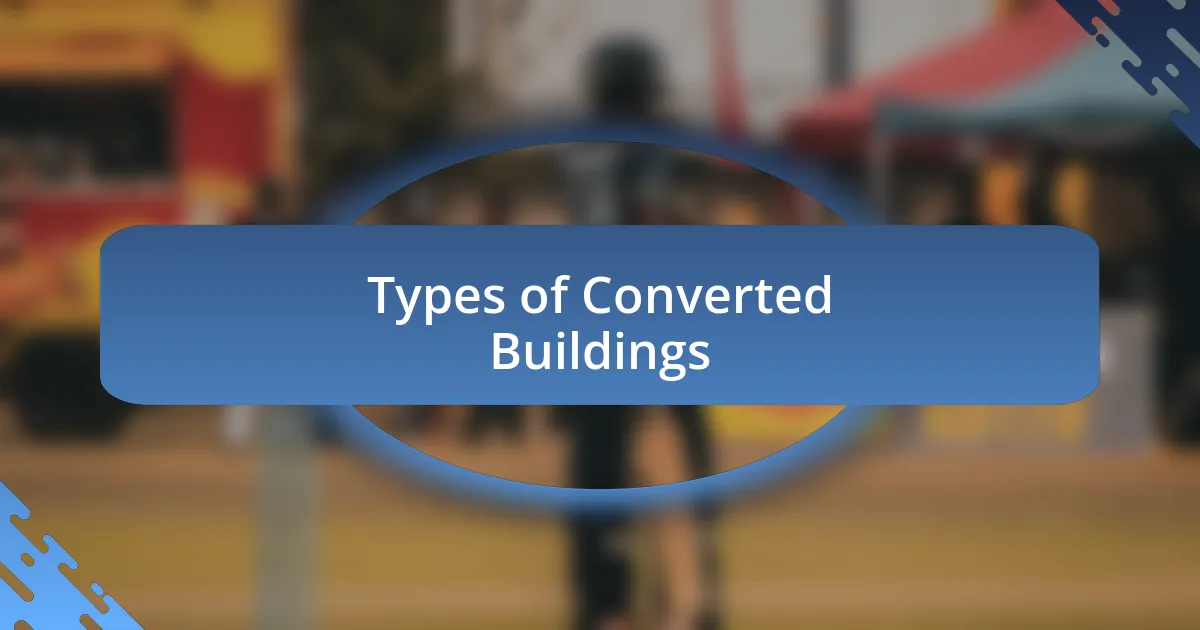Key takeaways:
- Converted buildings, such as warehouses, churches, and factories, combine unique architectural features with modern living, offering a rich historical context.
- Choosing a location for a converted building is essential, considering accessibility, nearby amenities, safety, and potential for property value appreciation.
- Personalizing converted spaces with decor, embracing unique architectural quirks, and using warm lighting can enhance comfort and create a cozy atmosphere.
- Preserving historical elements while supporting local artisans helps keep the character of converted buildings alive and engages residents with their history.

Types of Converted Buildings
When I think about the charm of converted buildings, one type that comes to mind is the warehouse conversion. These spaces often have high ceilings and expansive open layouts, which give a unique sense of freedom. The first time I stepped into a converted warehouse, I was struck by the juxtaposition of its industrial past and the modern touches that had been artfully incorporated – it felt like a canvas waiting for life to be painted around it.
Another fascinating category is the church conversion. I remember visiting a friend’s new home in a repurposed church, where stained glass windows cast colorful light across the living space. It sparked a sense of reverence in me; how can a former place of worship so beautifully transform into a cozy home? The architectural features many churches possess can turn everyday living into something extraordinary, don’t you think?
Then there are the factory conversions, often transformed into trendy lofts or artisanal spaces. I once attended a gallery opening in a former textile factory, and the raw, unfinished elements of the building really complemented the art displayed. It reminded me how our environments can influence our creativity and mood. Have you ever noticed how an interesting space can inspire fresh perspectives? It truly emphasizes the beauty of breathing new life into old structures.

Choosing the Right Location
When it comes to choosing the right location for your converted building, several factors come into play. I learned that accessibility is key; being near public transportation or main roads makes daily life so much smoother. I recall my brief stint in a converted schoolhouse that was charming but a bit isolated, which often made me long for easier access to restaurants and shops.
Here are some essential aspects to consider when selecting a location:
- Proximity to work or major transport links
- Nearby amenities like grocery stores, parks, and restaurants
- Safety of the neighborhood and community vibe
- Historic charm and character of the area
- Potential for appreciation in property value
Finding the right location truly has a significant impact on how you experience living in a converted building. I once lived in a repurposed mill located in a thriving arts district, which saturated my life with creativity and community interaction—it made a world of difference!

Understanding the Unique Features
Understanding a converted building’s unique features is crucial for anyone considering such a lifestyle. The architectural character often reflects its original purpose, leading to distinctive design elements. In my experience, living in a former factory, I found exposed beams and high ceilings not only aesthetically pleasing but also offered a sense of spaciousness that modern apartments lack. Each feature tells a story, immersing you in the building’s history and giving a unique context to your daily life.
Some converted buildings incorporate sustainable design practices that they did not initially have, enhancing their eco-friendliness. I noticed during my lease in a former church, how large windows not only provided abundant natural light but also minimized energy consumption. Embracing such features can create a more sustainable living environment, allowing residents to connect with both history and nature in a surprising way.
Moreover, the community atmosphere often cultivated in converted spaces contributes greatly to the lifestyle of residents. Living in a transformed warehouse, I found that the close-knit community, comprising artists and young professionals, fostered a shared enthusiasm for creativity and collaboration. This unique blend of architecture and community can make living in a converted building a truly enriching experience.
| Unique Feature | Personal Experience |
|---|---|
| Architectural Character | Living in a former factory provided spaciousness with exposed beams. |
| Sustainable Design | My time in a converted church highlighted the eco-friendly benefits of large windows. |
| Community Vibe | The warehouse I lived in fostered creativity and collaboration among like-minded residents. |

Tips for a Comfortable Stay
When staying in a converted building, consider personalizing your space to enhance comfort. I vividly remember how adding soft textiles, like area rugs and cushions, made my living area feel warmer and more inviting. Have you ever walked into a space that felt too sterile? By introducing your unique decor, you can transform the atmosphere, making it a true reflection of your personality.
Another tip is to embrace the quirks of the architecture while prioritizing your comfort. For instance, in my apartment within an old courthouse, I quickly learned that the original hardwood floors were beautiful but chilly. I invested in cozy throw blankets and slippers to counteract the cool flooring, creating a comfy sanctuary that still respected the building’s charm. Small adjustments can make a substantial difference in your overall experience.
Lastly, don’t overlook the significance of good lighting in such unique spaces. I discovered the value of warm-toned lamps, especially in a former industrial space with large, harsh windows. By softening the light, I created a welcoming ambiance that invited relaxation after long days. Have you thought about how lighting can influence your mood? The right fixtures can turn any converted room into a cozy retreat, making every moment spent there delightful.

Preserving History during Your Visit
It’s fascinating to consider how visiting converted buildings not only lets us enjoy modern comforts but also allows us to engage with history. I remember exploring a former textile mill turned loft, and you could still see remnants of its industrial past—exposed brick walls and original beams. Did you ever think about how these elements tell stories of a bygone era? They’re like whispers from the past, reminding us of the lives once lived within those walls.
Preserving history means being mindful of the building’s original features while enjoying the space. In a converted church I once stayed in, I noticed the stunning stained glass windows that infused the room with colorful light, creating an atmosphere of serenity. Instead of covering those windows with heavy draperies, I chose sheer curtains to keep them visible and appreciated. How do you honor the character of a place you’re staying in? It’s about finding ways to integrate the unique aspects of the building into your daily experience.
Additionally, what’s crucial is supporting local artisans and businesses during your visit. I learned that seeking out handmade products or historical tours not only enhances my understanding of the place but also contributes to its preservation. Isn’t it rewarding to feel like you’re part of preserving something meaningful? Each purchase or experience helps keep the history alive, ensuring that future generations can enjoy and learn from these remarkable spaces.


